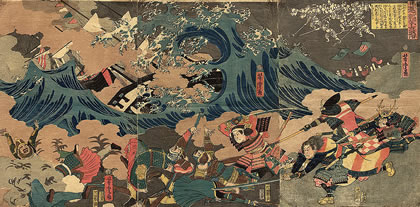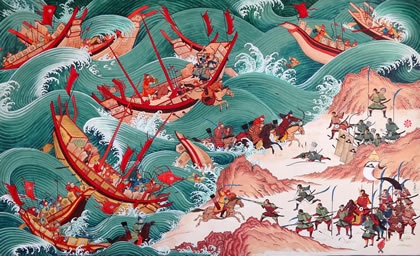World History
Kubilai Khan, Mongol ruler and founder of the Yuan dynasty (1279–1368) in China, twice attempted to invade Japan, in 1274 and 1281, with huge armadas launched from Korea and China. He failed both times mainly because of weather.
Japan thus never suffered under Mongol rule. The Japanese attributed their deliverance to the divine wind, kamikazi in Japanese. In 1260 Kubilai Khan seized leadership of the Mongol empire on the death of his elder brother, Mongke Khan, in a disputed succession.
Kubilai Khan established his capital in North China, at the site of the former Jin (Chin) dynasty capital, which he called Dadu (T’atu), meaning great capital in Chinese (present-day Beijing). He continued his brother’s unfinished work of destroying the Southern Song (Sung) dynasty and embarked on a new adventure even before that task was completed in 1279.
In 1268 he sent his first embassy to Japan demanding tribute. The Japanese emperor, by then a figurehead residing in Kyoto, was willing to acquiesce. But real power belonged to the shogun or military commander and his court at Kamakura, which rebuffed the repeated Mongol demands.
Thus Kubilai Khan decided to invade Japan to force compliance. His Korean subjects were ordered to build 400 large and 500 small ships, which set sail from Pusan in Korea in November 1274.
The invasion force had 15,000 Chinese and Mongol soldiers, 6,000–8,000 Korean troops, and 7,000 Korean sailors. The defending Japanese warriors (samurai) were far less numerous and suffered serious losses in the battle fought at Hataka on Kyushu Island. However they were saved by a fierce storm that blew in.
The Korean sailors persuaded the Mongol troops to board their ships and sail for safety in the open seas. The storm, however, damaged and sank many of the ships and 13,000 lives were lost; the survivors eventually limped home.
Kubilai Khan finished the destruction of the Southern Song in 1279. Then he focused on subjugating Japan. In 1281 he dispatched a huge force, reputedly of 140,000 men, in two armadas that sailed from China and Korea for Hataka.
Anticipating the Mongols’ return the Japanese had mobilized and built a wall to the interior of Hataka Bay. After about two months of desultory fighting, another fierce storm or typhoon blew in and destroyed most of the Mongol fleet.
Some survivors fled back to Korea; the rest were slaughtered or enslaved by the Japanese. Kubilai prepared for a third invasion, but the effort was abandoned after he died in 1294. However the shogunate continued a state of military alert until 1312. The cost of the defenses fell mainly to the people of Kyushu Island.
The discontent generated eroded the power of the Hojo clan of the Kamakura Shogunate. Japanese credited the kamikazi for their deliverance and tried to resurrect this idea during the last days of World War II for salvation from defeat by the Allies.
- Kemmu Restoration
Emperor Go-Daigo In 1185 the young Japanese emperor Antoku, some seven or eight years old, was drowned in the Battle of Dannoura in the Inland Sea by his grandmother, rather than be captured by their enemies. The power of the Taira clan, with which he...
- Japanese Invasion Of Korea
Japanese Invasion of Korea Japanese warlord Toyotomi Hideyoshi dreamed of conquering China and launched two invasions of Korea, in 1592 and 1597, in order to do so. Although he ultimately failed, the wars inflicted terrible devastation on Korea. Because...
- Toyotomi Hideyoshi - Japanese General
Toyotomi HideyoshiToyotomi Hideyoshi was a Japanese lord who completed the unification of Japan begun by Oda Nobunaga and launched two invasions of the Korean Peninsula. Hideyoshi was born the son of a peasant and became a soldier in the army of Oda Nobunaga...
- History Of South Korea
History of South Korea. This short essay highlights the key events in the history of the Asian nation of South Korea. Of course, South Korea is a divided part of a single Korean nation. Since the taint of communism infected the northern part of the country,...
- Japan, Korea And 1597: A Year That Lives In Infamy
Japan, Korea and 1597: A Year That Lives in Infamy - Excerpt of a New York Times article detailing Japan's invasion of Korea in 1597 and Korean resentment lingering from it. From the site: When they invaded Korea 400 years ago, Japanese samurai...
World History
Mongol Invasions of Japan
 |
| Mongol Invasions of Japan |
Kubilai Khan, Mongol ruler and founder of the Yuan dynasty (1279–1368) in China, twice attempted to invade Japan, in 1274 and 1281, with huge armadas launched from Korea and China. He failed both times mainly because of weather.
Japan thus never suffered under Mongol rule. The Japanese attributed their deliverance to the divine wind, kamikazi in Japanese. In 1260 Kubilai Khan seized leadership of the Mongol empire on the death of his elder brother, Mongke Khan, in a disputed succession.
Kubilai Khan established his capital in North China, at the site of the former Jin (Chin) dynasty capital, which he called Dadu (T’atu), meaning great capital in Chinese (present-day Beijing). He continued his brother’s unfinished work of destroying the Southern Song (Sung) dynasty and embarked on a new adventure even before that task was completed in 1279.
  |   |
In 1268 he sent his first embassy to Japan demanding tribute. The Japanese emperor, by then a figurehead residing in Kyoto, was willing to acquiesce. But real power belonged to the shogun or military commander and his court at Kamakura, which rebuffed the repeated Mongol demands.
Thus Kubilai Khan decided to invade Japan to force compliance. His Korean subjects were ordered to build 400 large and 500 small ships, which set sail from Pusan in Korea in November 1274.
The invasion force had 15,000 Chinese and Mongol soldiers, 6,000–8,000 Korean troops, and 7,000 Korean sailors. The defending Japanese warriors (samurai) were far less numerous and suffered serious losses in the battle fought at Hataka on Kyushu Island. However they were saved by a fierce storm that blew in.
The Korean sailors persuaded the Mongol troops to board their ships and sail for safety in the open seas. The storm, however, damaged and sank many of the ships and 13,000 lives were lost; the survivors eventually limped home.
Kubilai Khan finished the destruction of the Southern Song in 1279. Then he focused on subjugating Japan. In 1281 he dispatched a huge force, reputedly of 140,000 men, in two armadas that sailed from China and Korea for Hataka.
 |
| The defending Japanese warriors (samurai) were far less numerous |
Anticipating the Mongols’ return the Japanese had mobilized and built a wall to the interior of Hataka Bay. After about two months of desultory fighting, another fierce storm or typhoon blew in and destroyed most of the Mongol fleet.
Some survivors fled back to Korea; the rest were slaughtered or enslaved by the Japanese. Kubilai prepared for a third invasion, but the effort was abandoned after he died in 1294. However the shogunate continued a state of military alert until 1312. The cost of the defenses fell mainly to the people of Kyushu Island.
The discontent generated eroded the power of the Hojo clan of the Kamakura Shogunate. Japanese credited the kamikazi for their deliverance and tried to resurrect this idea during the last days of World War II for salvation from defeat by the Allies.
- Kemmu Restoration
Emperor Go-Daigo In 1185 the young Japanese emperor Antoku, some seven or eight years old, was drowned in the Battle of Dannoura in the Inland Sea by his grandmother, rather than be captured by their enemies. The power of the Taira clan, with which he...
- Japanese Invasion Of Korea
Japanese Invasion of Korea Japanese warlord Toyotomi Hideyoshi dreamed of conquering China and launched two invasions of Korea, in 1592 and 1597, in order to do so. Although he ultimately failed, the wars inflicted terrible devastation on Korea. Because...
- Toyotomi Hideyoshi - Japanese General
Toyotomi HideyoshiToyotomi Hideyoshi was a Japanese lord who completed the unification of Japan begun by Oda Nobunaga and launched two invasions of the Korean Peninsula. Hideyoshi was born the son of a peasant and became a soldier in the army of Oda Nobunaga...
- History Of South Korea
History of South Korea. This short essay highlights the key events in the history of the Asian nation of South Korea. Of course, South Korea is a divided part of a single Korean nation. Since the taint of communism infected the northern part of the country,...
- Japan, Korea And 1597: A Year That Lives In Infamy
Japan, Korea and 1597: A Year That Lives in Infamy - Excerpt of a New York Times article detailing Japan's invasion of Korea in 1597 and Korean resentment lingering from it. From the site: When they invaded Korea 400 years ago, Japanese samurai...
